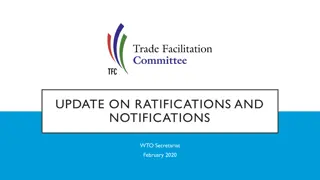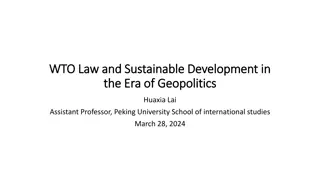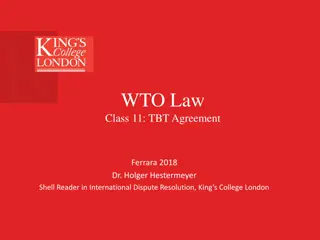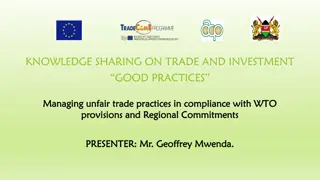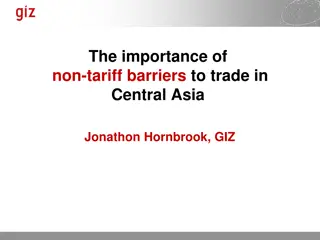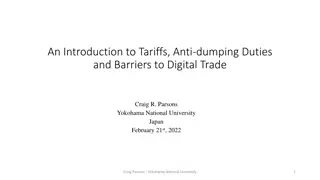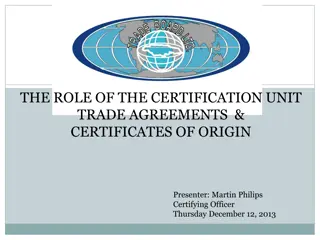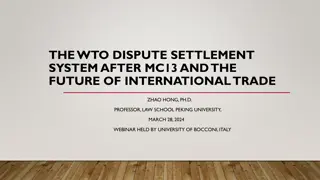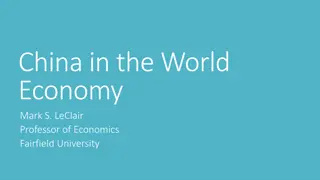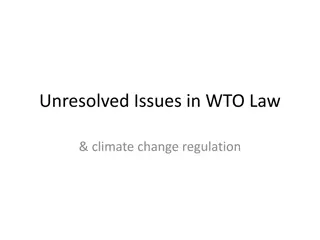Overview of the World Trade Organization (WTO)
The World Trade Organization (WTO) is an intergovernmental organization established in 1995 to regulate international trade among nations, replacing the General Agreement on Tariffs and Trade (GATT). It deals with trade in goods, services, and intellectual property, aiming to create trade agreements, resolve disputes, and prevent discrimination. The WTO's structure includes the Ministerial Conference, General Council, and various Trade Councils, each playing a key role in decision-making and policy implementation.
Download Presentation

Please find below an Image/Link to download the presentation.
The content on the website is provided AS IS for your information and personal use only. It may not be sold, licensed, or shared on other websites without obtaining consent from the author. Download presentation by click this link. If you encounter any issues during the download, it is possible that the publisher has removed the file from their server.
E N D
Presentation Transcript
WORLD TRADE ORGANIZATION (WTO)
The World Trade Organization (WTO) is an intergovernmental organization that is concerned with the regulation of international trade between nations. The WTO officially commenced on 1 January 1995 under the Marrakesh Agreement, signed by 123 nations on 15 April 1994, replacing the General Agreement on Tariffs and Trade (GATT), which commenced in 1948. It is the largest international economic organization in the world. The WTO deals with regulation of trade in goods, services and intellectual property between participating countries by providing a framework for negotiating trade agreements and a dispute resolution process aimed at enforcing participants' adherence to WTO agreements, which are signed by representatives of member governmentsand ratified by their parliaments. The WTO prohibits discrimination between trading partners, but provides exceptions for environmental protection, national security, and other important goals. Trade- related disputes are resolved by independent judges at the WTO through a dispute resolution process.
Structure of the World Trade Organization
Ministerial Conference WTO is headed by the Ministerial Conference who enjoys absolute authority over the institution. It not only carries out functions of the WTO but also takes appropriate measures to administer the new global trade rules. It is integrated by representatives of all WTO Members and shall meet at least once in every two years. It is the chief policy-making body of WTO and any major policy changes, such as a decision to alter competition policy or to rewrite the WTO agreement, require its approval. General Council In addition to these, the structure of the WTO consists of a General Council to oversee the WTO agreement and ministerial decisions on a regular basis. It is also formed by the representatives of all WTO Members and acts on behalf of Ministerial Conference whenever the Conference is not in sessions. The General Council also meets as the Dispute Settlement Body and the Trade Policy Review Body. The Council sits in its headquarters Geneva, Switzerland usually once a month.
Trade Councils Besides General Council, there is the Council for Trade in Goods, the Council for Trade in Services, the Council for Trade-Related Intellectual Property Rights (TRIPS). These Councils and their respective subsidiary bodies perform their respective functions. Each member has one vote. Decision-making is made by consensus. If consensus is not reached then majority voting plays the crucial rate. In addition to these councils, Working Parties can be established by the General Council in order to deal with specific issues defined by General Council. Secretariat The WTO secretariat (numbering 625 of many nationalities) is headed by Director General who is appointed by Ministerial Conference. The Secretariat of the WTO is responsible for servicing the WTO bodies with respect to negotiations and the implementation of agreements. Since decisions are taken by Members only, Secretariat has no decision making power.
Functions of the World Trade Organization
The WTO was founded on certain guiding principlesnon-discrimination, free trade, open, fair and undistorted competition, etc. In addition, it has a special concern for developing countries. At the heart of the Organization are the WTO agreements, negotiated and signed by the bulk of the world s trading nations. The goal is to help producers of goods and services, exporters, and importers conduct their business. The WTO s overriding objective is to help trade flow smoothly, frets, fairly, and predictably.
With these objectives in mind, WTO is performing following functions: 1. It shall facilitate the implementation, administration, and operation of the WTO trade agreements, such as multilateral trade agreements and plurilateral trade agreements. 2. It shall provide a forum for liberalization negotiations among its members concerning their multilateral trade relations. 3. It shall administer the Dispute Settlement Procedure so as to handle trade disputes. 4. It shall monitor national trade policies (including Trade Policy Review Mechanism). 5. It shall cooperate with various international organizations like the IMF and the World Bank with the aim of achieving greater coherence in global economic policy-making. 6. It shall provide technical assistance and training for members of the developing countries.
The process of becoming a WTO member is unique to each applicant country, and the terms of accession are dependent upon the country's stage of economic development and current trade regime. The process takes about five years, on average, but it can last longer if the country is less than fully committed to the process or if political issues interfere. The shortest accession negotiation was that of the Kyrgyz Republic, while the longest was that of Russia, which, having first applied to join GATT in 1993, was approved for membership in December 2011 and became a WTO member on 22 August 2012.[83]Kazakhstan also had a long accession negotiation process. The Working Party on the Accession of Kazakhstan was established in 1996 and was approved for membership in 2015.The second longest was that of Vanuatu, whose Working Party on the Accession of Vanuatu was established on 11 July 1995. After a final meeting of the Working Party in October 2001, Vanuatu requested more time to consider its accession terms. In 2008, it indicated its interest to resume and conclude its WTO accession. The Working Party on the Accession of Vanuatu was reconvened informally on 4 April 2011 to discuss Vanuatu's future WTO membership. The re- convened Working Party completed its mandate on 2 May 2011. The General Council formally approved the Accession Package of Vanuatu on 26 October 2011. On 24 August 2012, the WTO welcomed Vanuatu as its 157th member.[85]An offer of accession is only given once consensus is reached among interested parties.



